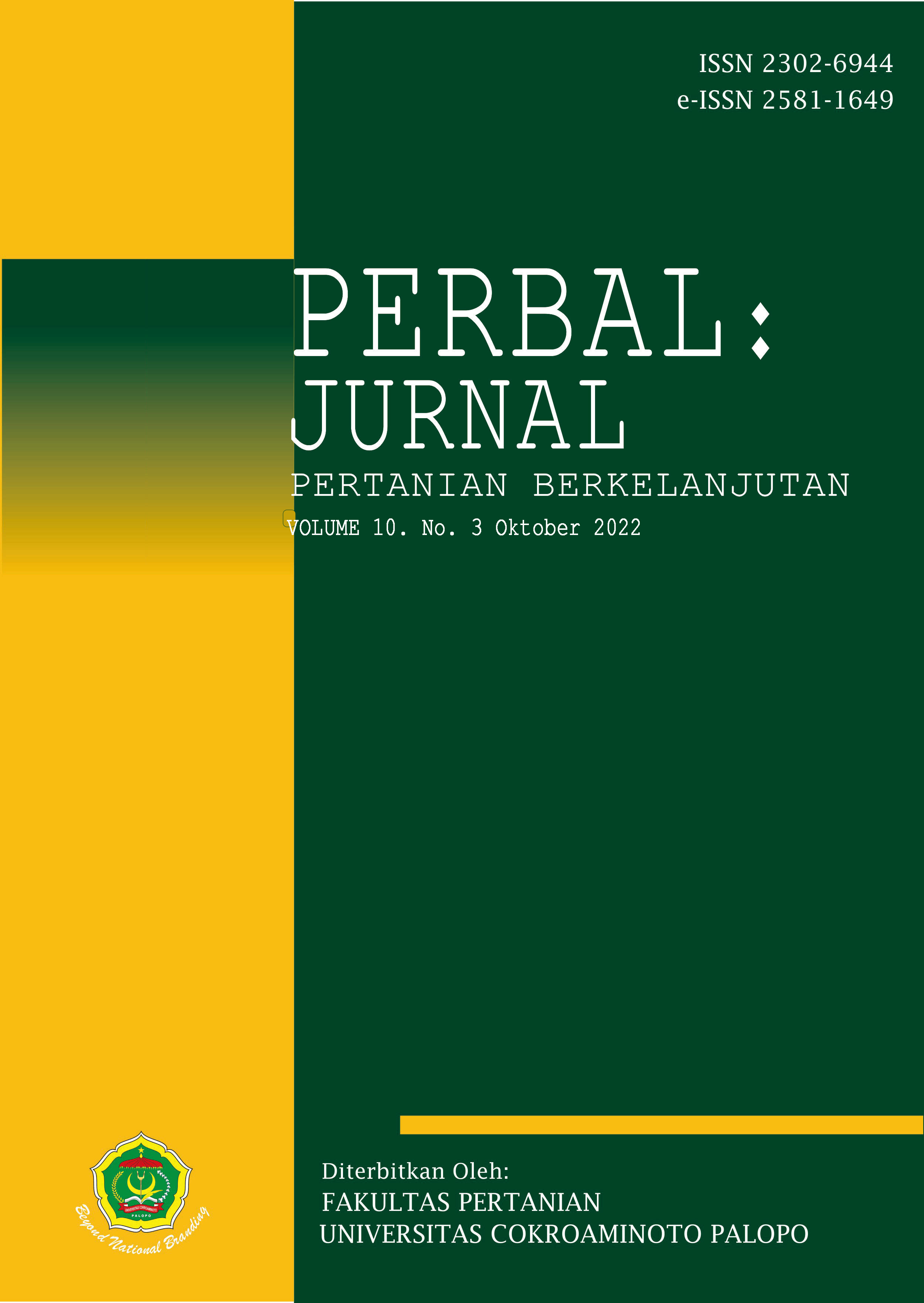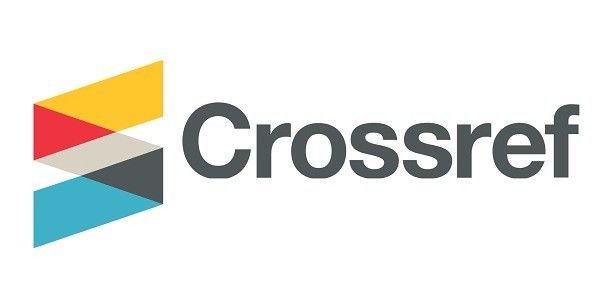Respon Tanaman Semangka (Citrullus vulgaris L.) pada Berbagai Pemangkasan Buah Semangka
The Response of Watermelon Plants (Citrullus vulgaris L.) to Various Watermelon Fruit Pruning
DOI:
https://doi.org/10.30605/perbal.v10i3.2102Keywords:
buah, pemangkasan, semangkaAbstract
Penelitian bertujuan untuk mengetahui respon tanaman semangka pada berbagai pemangkasan buah. Penelitian ini berlangsung dari September 2021 sampai Februari 2022 di Desa Palopo Kecamatan Marisa Kabupaten Pohuwato. Penelitian ini menggunakanRancangan Acak Kelompok yang terdiri dari tanpa pemangkasan (S0), satu buah dipertahankan (S1), dua buah dipertahankan (S2), dan tiga buah dipertahankan (S3), diulang sebanyak 4 kali. Perlakuan S1 memberikan hasil terbaik pada parameter bobot buah semangka (4,940 kg) dan lingkar buah semangka (66,175 cm). Sedangkan perlakuan S3 memberikan hasil terbaik pada parameter panjang tanaman semangka (219,750 cm) dan jumlah daun tanaman semangka (114,300 helai).
The aim of the study is to determine the response of watermelon plants to various fruit pruning. This research was conducted from September 2021 to February 2022 in Palopo Village, Marisa District, Pohuwato Regency. This study used a randomized group design, which consisted of no pruning (S0), one retained (S1), two retained (S2), and three retained (S3), repeated until 4 times. The S1 treatments give the best results on the parameters of watermelon fruit weight (4.940 kg) and watermelon fruit circumference (66.175 cm). While the S3 treatment give the best results on the parameters of the length of the watermelon plant (219,750 cm) and the number of leaves of the watermelon plant (114,300 leaves).
Downloads
References
Alfin, S. (2016). Pengaruh Pemangkasan Cabang Primer dan Cabang Sekunder terhadap Pertumbuhan dan Hasil Buah Semangka (Citrullus vulgaris Schard). Skripsi. Program Studi Agroteknologi Fakultas Pertanian Universitas Andalas. Padang.
Ariesya, V. S. (2022). Analisis Perbandingan Pendapatan Buah Semangka Merah Non Biji dengan Semangka Kuning di Kelurahan Tanah Merah Kecamatan Binjai Selatan. Skripsi. Fakultas Pertanian. Universitas Muhammadiyah Sumetera Utara. Medan.
Cindy. (2018). Pengaruh Kombinasi Jarak Tanam dan Pemangkasan pada Pertumbuhan dan Hasil Tanaman Semangka. Skripsi. Minat Budidaya Pertanian Program Studi Agroekoteknologi Fakultas Pertanian Universitas Brawijaya. Malang.
Harjadi, S.S. (2019). Dasar-dasar Agronomi. Gramedia Pustaka Utama. Jakarta.
Hodijah. (2019). Pengaruh Pemangkasan Cabang dan Jarak Tanam terhadap Pertumbuhan dan Produksi Tanaman Semangka (Citrullus vulgaris Schard). Skripsi. Program Studi Agroteknologi Fakultas Pertanian Universitas Medan Area. Medan.
Panggabean, F. D.M., L. Mawarni, dan T. C. Nissa. (2014). Respon pertumbuhan dan produksi bengkuang (Pachyrhizus erosus L.) terhadap waktu pemangkasan dan jarak tanam. Jurnal Online Agroteknologi. Volume 2 Nomor 2 Halaman 702-711.
Prajnanta, F. (2003). Agribisnis Semangka Non Biji. Penebar Swadaya. Jakarta.
Purba, J. O., A. Barus dan Syukri. (2015). Respon pertumbuhan dan produksi semangka (Citrullus vulgaris Schard.) terhadap pemberian pupuk NPK (15:15:15) dan pemangkasan buah. Jurnal Online Agroekoteknologi Volume 3 Nomor 2 Halaman 595-605.
Sekartini, E. dan D. N. Azizah. (2020). Mempelajari konsentrasi pure buah semangka (Citrullus lanatus) terhadap karakteristik es krim. Jurnal Edufortech. Volume 5 Nomor 2 Halaman 137-146.
Sinaga, R. H. (2017). Respon Pertumbuhan dan Produksi Beberapa Varietas Semangka (Citrullus vulgaris Schard) terhadap Pemberian Pupuk KCl. Skripsi. Program Studi Agroteknologi Fakultas Pertanian Universitas Muhammadiyah Sumatera Utara. Medan.
Yuriani, A. D., E. Fuskhah, dan Yafizham. (2019). Pengaruh waktu pemangkasan pucuk dan sisa buah setelah penjarangan terhadap hasil produksi tanaman semangka (Citrullus vulgaris Schard). Jurnal Agro Complex. Volume 3 Nomor 1 Halaman 55-64.
Downloads
Published
Issue
Section
License
In submitting the manuscript to the journal, the authors certify that:
- They are authorized by their co-authors to enter into these arrangements.
- The work described has not been formally published before, except in the form of an abstract or as part of a published lecture, review, thesis, or overlay journal.
- That it is not under consideration for publication elsewhere,
- That its publication has been approved by all the author(s) and by the responsible authorities – tacitly or explicitly – of the institutes where the work has been carried out.
- They secure the right to reproduce any material that has already been published or copyrighted elsewhere.
- They agree to the following license and copyright agreement.
License and Copyright Agreement
Authors who publish with Onoma Journal: Education, Languages??, and Literature agree to the following terms:
- Authors retain copyright and grant the journal right of first publication with the work simultaneously licensed under Creative Commons Attribution License (CC BY 4.0) that allows others to share the work with an acknowledgment of the work's authorship and initial publication in this journal.
- Authors are able to enter into separate, additional contractual arrangements for the non-exclusive distribution of the journal's published version of the work (e.g., post it to an institutional repository or publish it in a book), with an acknowledgment of its initial publication in this journal.
- Authors are permitted and encouraged to post their work online (e.g., in institutional repositories or on their website) prior to and during the submission process, as it can lead to productive exchanges, as well as earlier and greater citation of published work.














